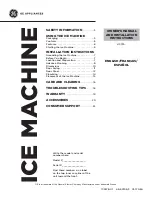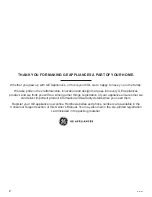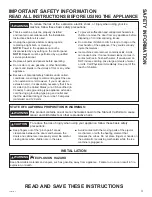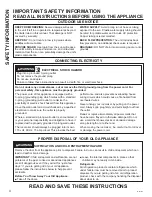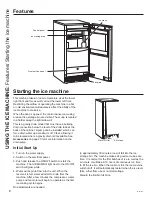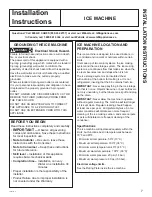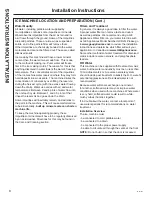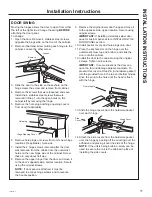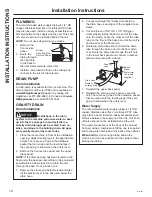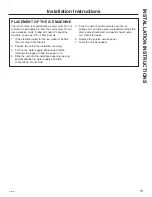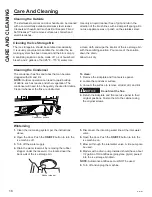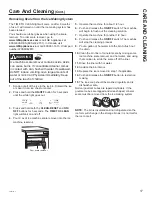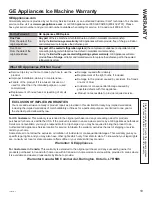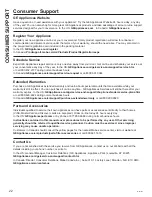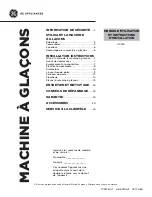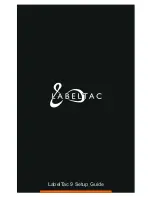
8
49-60745-3
Installation Instructions
INST
ALLA
TION INSTRUCTIONS
ICE MACHINE LOCATION AND PREPARATION (Cont.)
Water Quality
All water, including potable water supplied by
municipalities, contains some impurities or minerals.
Water absorbs impurities from the air as rain and/or
as it flows through the ground. Some of the impurities
are solid particles. These are known as suspended
solids, and a fine particle filter will remove them.
Other impurities are chemically bonded to the water
molecules and cannot be filtered out. These are called
dissolved solids.
Ice made by this machine will have a lower mineral
content than the water it was made from. This is due
WRWKHPHWKRGRIPDNLQJLFH3XUHUZDWHUZLOOIUHH]H
first in the ice making molds. The reason for this is that
DQ\WKLQJGLVVROYHGLQZDWHUORZHUVWKHZDWHUVIUHH]LQJ
temperature. This concentrates most of the impurities
of the ice machine water reservoir where they may form
hard deposits known as scale. The machine dilutes the
concentration of minerals by over-filling the reservoir
GXULQJWKHKDUYHVWF\FOHZLWKWKHH[FHVVZDWHUIORZLQJ
GRZQWKHGUDLQ:DWHUXVHYDULHVZLWKDLUDQGZDWHU
temperatures. Between 2 and 4 pints of water flow into
the unit each cycle. Between 1 and 3.5 pints of that
rinses the reservoir and goes down the drain.
Some impurities will inevitably remain, and will stick to
the parts in the machine. This will cause malformed ice
cubes. Eventually,
built up mineral scale can shorten
machine life.
To keep the machine operating properly, these
impurities or minerals will have to be regularly dissolved
by an acid cleaner. Directions for this may be found in
the Care and Cleaning section.
Filters and Treatment
In general, it is always a good idea to filter the water.
A proper water filter can remove taste and odors
as well as particles. We recommend using a GE
$SSOLDQFHV:DWHU)LOWHURQ\RXUZDWHULQOHWOLQHVXFK
DV*($SSOLDQFHV0RGHO1XPEHU*;5/43OHDVHJR
to
www.geappliances.com
to review the installation
instructions and determine which filter will suit your
application. In Canada visit
www.GEAppliances.ca.
Some other methods of water treatment for dissolved
solids include reverse osmosis, and polyphosphate
feeders.
RO Water
This machine can be supplied with Reverse Osmosis
water, but the water conductivity must be no less than
PLFUR6LHPHQWVFP$UHYHUVHRVPRVLVV\VWHP
should include post treatment to satisfy the R.O. water's
SRWHQWLDODJJUHVVLYHQHVV'HLRQL]HGZDWHULVQRW
recommended.
Because water softeners exchange one mineral
for another, softened water may not improve water
conditions when used with ice machines. Where water
is very hard, softened water could result in white,
mushy cubes that stick together.
If in doubt about the water, contact a local point of
use water specialist for recommendations on water
treatment.
Installation Overview
The ice machine must:
- be connected to cold, potable water
- be connected to a drain
- be connected to the proper power supply
- be able to circulate air through the vents at the front
NOTE:
Do not build in so that the door is recessed.
Summary of Contents for UCC15
Page 21: ...49 60745 3 21 NOTES Notes ...
Page 43: ...49 60745 3 21 NOTES Notes ...
Page 44: ...22 49 60745 3 NOTES Notes ...
Page 45: ...49 60745 3 23 NOTES Notes ...
Page 67: ...49 60745 3 21 NOTAS Notas ...

